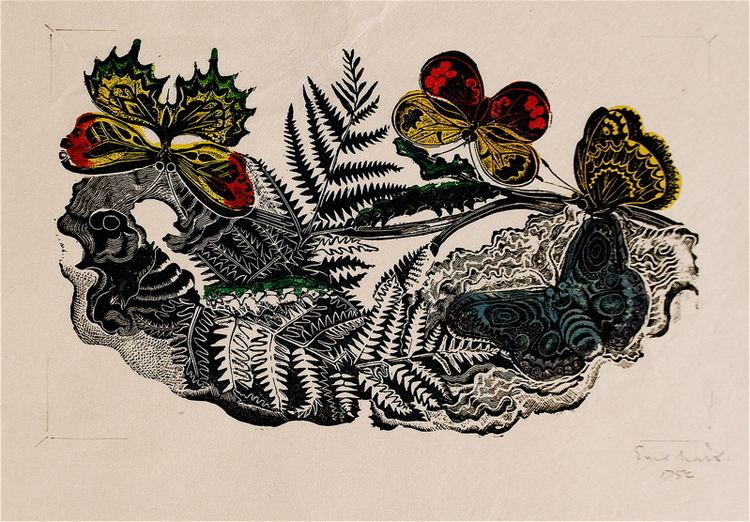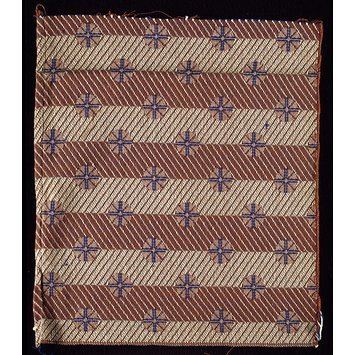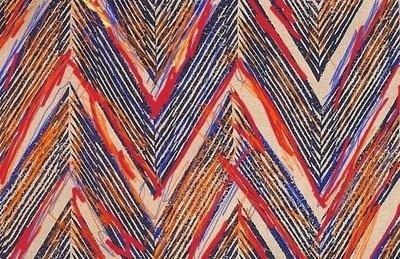Name Enid Marx | ||
 | ||
Died May 18, 1998, London, United Kingdom | ||
Enid Crystal Dorothy Marx, RDI (20 October 1902 – 18 May 1998), was an English painter and designer, best known for her industrial textile designs for the London Transport Board and the Utility Furniture Scheme. Marx was the first female engraver to be designated as a Royal Designer for Industry.
Contents
- Early life
- Education
- Career
- Textile design
- Industrial textiles
- Book design
- Other selected work
- Popular and traditional art
- Honors
- Personal life
- Widely Published
- Art Books
- Childrens Books
- References

Early life

Born in London to Robert Joseph Marx and Annie Marie Neuberger, Enid Marx was the youngest of three children. She was known familiarly throughout her life as "Marco".

Her father was a paper-making engineer, and Marx would later describe his work as a major influence on her interest in mass-produced design and popular art.

Her artistic inclinations were fostered from an early age, especially by her older sister Marguerite who lived in France for a period. Enid found pleasure as a young girl in collecting samples of ribbon from textile shops. She traveled with her family in Europe before the First World War, witnessing the avant-garde arts movements of the early 20th century.
Education
Marx attended the Roedean School for girls from 1916 until 1921, and her artistic studies there included life drawing, printing, and carpentry. She studied at the Central School of Arts and Crafts for a year before moving to the painting school at the Royal College of Art in 1922. Her classmates there included Edward Bawden, Eric Ravilious, Barbara Hepworth, and Barnett Freedman. As a student, Marx was influenced by Paul Nash, then a tutor at the RCA, who introduced her to publishers and encouraged her avant-garde leanings. Marx failed her Final Diploma Assessment (led by Charles Ricketts) in 1925, and she left the school that year. Her work was judged to be "vulgar", reflecting her interest in popular forms and rejection of the traditional definition of fine arts. Nearly sixty years later, in 1982, the College awarded her an honorary degree.
Career
Marx was a versatile artist whose work spanned industrial design and the visual arts. She valued craft and folk art, and derived inspiration for her work from her collections of vernacular artwork and everyday objects. Although she is best-known for her textile and book design, she also designed wrapping paper, stamps, and Christmas cards.
Textile design
In 1925, after leaving school before finishing her degree, Marx went to work for the textile designers Phyllis Barron and Dorothy Larcher at their studio in Hampstead. In 1927 she started her own workshop where she designed and produced block-printed textiles, often making use of naturally-derived dyes instead of new chemical methods. Her work was sold through the Little Gallery, off Sloane Street, and later at Cecilia Dunbar Kilburn's Dunbar Hay gallery. Collectors of her work included the actors Gerald du Maurier and Gertrude Lawrence.
Industrial textiles
In 1937 she was selected by the London Passenger Transport Board to design the moquette seat fabrics for use on the seats of London buses and tube trains. The new seat fabrics were part of a customer-experience centered redesign, spearheaded by Christian Barman and Frank Pick, focusing on interior fabrics and surfaces. The moquettes were designed to very specific standards, with patterns meant to hide wear and dirt but avoid the problem of "dazzle," their term for the potentially nauseating effects of a pattern in motion. Four of Marx's thirteen original designs are known to have been produced as a part of this redesign, including a "shield" pattern that was used in the London Underground for decades.
During the design and production process for these fabrics, Marx expressed displeasure with the manufacturing firms, who took liberties with the designs to conform to manufacturing requirements. Marx believed that time and effort could have been saved if the manufacturers had consulted with her before making the necessary modifications. The pattern used for the seats and interior backdrops was a geometric design in green and red.
In 1943, the furniture designer Gordon Russell invited her to become a member of the Board of Trade Utility Furniture Design Advisory Panel, which was tasked with implementing wartime austerity standards in the field of interior and furniture design. She became responsible for its range of textiles, eventually creating over 30 commissioned designs. This work represented a challenge for the designer because the patterns had to be attractive yet simple in design and inexpensive to manufacture. Marx worked within the restraints of a limited number of looms, four board-selected colors, and only two yarn types. Unlike her experience with the London Passenger Transport commissions, Marx found the process of collaboration with manufacturers on Utility Furniture textiles to be a successful one. The textile patterns were primarily geometric, although Marx also introduced some floral motifs after seeking feedback from her charwoman.
Book design
In 1929 Marx designed her first commercial book cover, for a monograph on the engravings of Albrecht Dürer. She created patterned papers for the Curwen Press and received further commissions from Chatto and Windus. During the Second World War, she began writing and illustrating her own small format children's books, including Bulgy the Barrage Balloon (1941) and The Pigeon Ace.
After the war Marx designed covers for Penguin Books. She finished an engraving series called Marco's Animal Alphabet in 1979, although it was not published until after her death.
Other selected work
Marx designed the frame around the portrait of Queen Elizabeth II on the British Wilding series of penny, halfpenny, and three-halfpenny stamps, and the 1976 Christmas stamp issue featuring medieval embroidery. During World War II, she was commissioned by The Pilgrim Trust to paint 14 watercolours of buildings under threat from bombing for its "Recording Britain" project.
In 1965 she became Head of Department of Dress, Textiles and Ceramics at Croydon College of Art, where she taught for five years before her retirement.
Popular and traditional art
From the late 1930s Marx and Lambert began collecting popular ephemera, such as scrapbooks, valentines, paper peepshows, children's books, Staffordshire dog figurines and toys. They used their collection as the basis for a book entitled When Victoria Began to Reign, published by Faber and Faber in 1937. In 1947 they published English Popular and Traditional Art (in the Collins Britain in Pictures series), and in 1951 English Popular Art was published.
In the introduction to the 1947 book they defined their subject as "the art which ordinary people have, from time immemorial, introduced into their everyday lives, sometimes making it themselves, at others imposing their tastes on the product of the craftsmen or of the machine". Marx and Lambert's collection of popular art was put on display at Compton Verney House in 2004.
Honors
Enid Marx became a member of the Society of Wood Engravers in 1925. She was awarded the distinguished status of Royal Designer for Industry by the British Royal Society of Arts in 1944. Marx was one of the designers chosen to exhibit in the Royal Pavilion at the Festival of Britain in 1951.
Personal life
During the late 1950s and 1960s, Marx lived with her partner Margaret Lambert in St Andrews, Scotland.Lambert lectured in history at St Andrews University. Marx died in London on 18 May 1998, aged 95.
